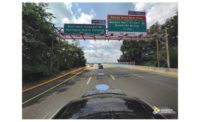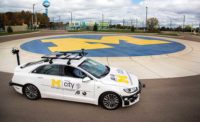Autonomous Vehicles Will Revolutionize Transportation; Smart Infrastructure Is Key

Tests of automated self-driving shuttles demonstrate how they can help conventional transit with “first mile-last mile” connectivity.
PHOTO BY NOAH BERGER, COURTESY OF CONTRA COSTA TRANSPORTATION AUTHORITY

Society of Automotive Engineers (SAE) Automation Levels

A proposed multi-modal redesign of Wilshire Boulevard in Los Angeles illustrates potential changes to once car-centric urban corridors.
IMAGE COURTESY OF LYFT/PERKINS+WILL/NELSON\NYGAARD

The CDOT-Arrivo City Zipper test system could propel vehicles at up to 250 mph on “sleds” through an enclosed, electromagnetic superhighway that uses magnetic levitation and electric power.
IMAGE COURTESY OF ARRIVO AND CDOT




In 1895, Thomas Edison called the nascent horseless carriage “a great invention,” facilitating commerce that would enrich a country “just as much as the discovery of vast hoards of gold.” It didn’t take long for others to embrace Edison’s view. The rapid 20- to 25-year shift from draft animals to an automobile-centric landscape now is often cited as precedent for the transformative effect of transportation’s latest game-changers—connected and autonomous vehicles.
In what seems like the flash of a headlight, the technology of computer-dominated mobility has advanced AVs from whiteboard chatter to on-the-road reality. And from a safety standpoint, that’s welcome news. An estimated 90% of the more than 6 million reported vehicle crashes each year are caused by human error. Add to that the U.S. Dept. of Transportation’s estimate that nearly 6,000 pedestrians were killed by vehicles on public roads in the U.S. in 2016, the highest number of such fatalities since 1990. While AVs do not promise zero accidents, the reduction of human error is likely to improve safety on the roads.
Early research, including a 2017 assessment by the Rand Corp., finds that the potential to significantly improve safety, optimize traffic flow and enhance accessibility makes deployment of AVs and their supporting infrastructure essential, even if the underlying artificial intelligence is still being perfected.
Connected vehicles—those capable of communicating with infrastructure systems and with each other to assist human operators—offer significant safety benefits, but it’s the rapidly evolving technology of independent, computer-controlled cars and trucks that gets the most interest, along with an expected degree of media hype.
Surveys show that much of the U.S. population remains wary of driverless vehicles—63% of adults fear taking a ride in one, according to a January AAA survey, although that’s down from 78% a year ago. Nevertheless, AVs are apparently here to stay, even if they have yet to fully arrive.
Tests of autonomous cars and shuttles on tracks and select corridors have been augmented with everyday pilot programs. Uber is running an AV-based ride-hailing service on the streets of Pittsburgh and AV tractor-trailers on Arizona’s highways. In Miami, partners Lyft, Ford and Domino’s are sponsoring AV-delivered pizzas.
Few of these pioneers expect AVs to take humans totally out of the equation, in both urban and rural areas. “We will not assume universal implementation of these technologies,” said U.S. Secretary of Transportation Elaine Chao at a recent U.S. DOT-sponsored AV summit in Washington, D.C.
But in contemplating the culture-changing potential of AVs, questions arise about what built-environment adaptations and enhancements may be needed for them to flourish. “We’re putting in infrastructure today that will last 40 to 50 years,” says Tom Fisher, director of the Minnesota Design Center and professor emeritus, College of Design, at the University of Minnesota. If a mass migration to AVs is inevitable, he asks, “how do we design now for the future?”
Because AV technology development has outpaced federal and state-level rulemaking, many DOTs find themselves catching up after being “left in the dust by developers,” says Dustin Parkman, vice president for civil, modeling and visualization in Bentley Systems’ Los Angeles office.
Don’t blame regulatory red tape, however. Laurie Matkowski, Gannett Fleming’s director of Connected and Automated Vehicle Services, sees culture gaps on both sides of the AV equation. “Technology companies don’t get what DOTs do, and why things are done that way,” she says.
While Parkman believes that reconciling the “different schools of thought about the direction of AV technology” makes any new guidance for adapting roadways at least two years away, some of the regulatory pieces have fallen into place. Since 2012, at least 41 states and the District of Columbia have considered or enacted some form of AV regulation.
Last September, the U.S. DOT issued version 2.0 of its guidance for development and deployment of Automated Driving Systems (ADS), which calls on states to “maintain a good state of infrastructure design, operation and maintenance” to support deployment of all levels of automated driving systems, including existing traffic-control devices. Both houses of Congress are considering legislation clarifying the government’s role in regulating AVs.
Related Articles:
Better Maps Seen as Key for Autonomous Vehicles
Colorado's RoadX Program Seeks Smarter Mobility
Autonomous Vehicle Test Sites Help Accelerate Deployment
AVs in the Wild
Nevertheless, Michigan DOT Director Kirk Steudle says policymakers must walk a fine line as the technology moves from closely controlled test conditions to what he calls “AVs in the wild.”
“If you’re overly restrictive, you constrain technology development,” Steudle says, adding that states remain “responsible for activities on the road.” Firms looking to test AVs have pursued agreements with municipalities to put vehicles in live traffic, but that aggressive strategy may shift after a recent AV-related fatality. Ride-hailing company Uber was running trials of its AVs in Tempe, Ariz., Toronto, San Francisco and Phoenix, but announced March 19 it will suspend tests following the death of a woman who was struck by an Uber AV on a Tempe street. The vehicle had a human driver at the wheel but was operating in autonomous mode at the time of the incident, according to a statement by Tempe police. Arizona currently allows AVs to operate in traffic without a human driver behind the wheel.
Still, most predictions call for connected vehicles and AVs with intermediate-level intelligence to be making significant inroads into the nation’s motor-vehicle stock by the early 2020s. After that, says Matt Smith, associate vice president and national AV/CV leader at Michael Baker International, “bullish predications” call for Level 5 technology—fully automated vehicle control as defined by the Society of Automotive Engineers—to filter down to more affordable vehicles over the following five years.
The transition of vehicles to those with higher levels of built-intelligence will then begin, Smith adds, reaching a concentration sometime in the 2040s that will require more significant changes to infrastructure design.
Until then, “we will still have to design primarily for humans behind the wheel,” he says, “with traffic signals, signs and other features we utilize today.”
U.S. DOT’s ADS 2.0 guidance does note that some roadway features currently considered low priority for human drivers may take on greater importance as vehicle systems begin to rely more on sensors to detect their locations. California already has taken a step in this direction, widening lane-marker lines from 4 in. to 6 in. and eliminating the use of nonreflective, raised-pavement markers (a.k.a. Botts dots) to make them more user-friendly for autonomous vehicles.
Waymo, Google’s AV-development subsidiary, has already logged more than 5 million test miles, mostly on public roads using existing roadway infrastructure, in several Western states. “The systems adapt to roadway conditions,” says Ryan Harding, a spokesman with the Arizona DOT, which has allowed testing across a full range of road settings. “That means what is good for human-driven vehicles—clear signage, lane markings and smooth pavement—is currently satisfactory for autonomous vehicles.”
A more urgent issue for states may be the wireless-communication hardware needed to integrate connected and autonomous vehicles with their operational environments (vehicle-to-infrastructure, or V2I), and to each other (vehicle-to-vehicle, or V2V). Networks of 5.9 GHz-band dedicated short-range communications (DSRC radios) are currently envisioned as the foundation for this digital infrastructure, although still-emerging 5G wireless technology may take on a greater share of “vehicle-to-everything” communication.
The American Association of State Highway and Transportation Officials (AASHTO) is encouraging transportation agencies to familiarize themselves with DSRC technology, challenging them to deploy DSRC infrastructure to broadcast traffic phase and signal timing (SPaT) data in at least one corridor with 20 signalized intersections by January 2020.
Maryland’s pilot corridor, a section of U.S. Route 1 between Washington and Baltimore, has been outfitted with upgraded signal-control infrastructure, cameras and other technology. “We want to see how the system performs, what data we get back and potential applications for mass transit systems,” says Joseph Sagal, who oversees highway technology development for Maryland DOT’s State Highway Administration. Sagal says that “2018 will be an interesting year” for AV infrastructure technology, “but we’re taking a conservative approach, and waiting for U.S. DOT’s guidance.”
But for every apparent certainty about the arrival of AVs, many other questions have yet to be answered. Opinions differ, for example, on whether AVs will follow the current century-long pattern of personal ownership or if the rising popularity of Uber, Lyft and other shared-mobility models will diminish that allure. A 2017 study by Arcadis, HR&A Advisors and Sam Schwartz Consulting forecasts that automated ridesharing and ride-sourcing services in the New York City, Los Angeles and Dallas-Fort Worth areas could shift nearly 7 million drivers into AVs over two decades.
Steudle, on the other hand, predicts that as AV technology becomes more affordable, the proportion of owners may remain relatively high. “The consumer will drive the choice,” he says.
AVs’ potential to increase roadway capacity also has trade-offs. Randell Iwasaki, executive director at Contra Costa Transportation Authority, Contra Costa, Calif., explains that the technology will safely allow reduced highway spacing for vehicles, so more users can use the same amount of paved real estate more efficiently.
“If you can turn two 12-foot lanes into three 8-foot lanes,” Iwasaki explains, “you’ve added more capacity with a minimal investment.” However, concentrating more vehicles in narrower lanes could accelerate pavement deterioration. The Virginia Tech Transportation Institute hopes to get a head start on finding answers with its new study on pavement stress.
“We’re setting up a pavement facility that can put 20 years of stress on a road in just a few months,” says Gerardo Flintsch, director of VTTI’s Center for Sustainable Transportation Infrastructure. He adds that modeling will be used to simulate a variety of real-world conditions and wear patterns.
Some experts worry that other factors might cause vehicle miles traveled (VMT) to balloon. Roads could be burdened with a growing number of empty, or “zombie,” AVs left idling between ride-hailing customers or sent back home by owners in lieu of finding parking for them. Similarly, bringing mobility to currently underserved or isolated populations, another oft-stated benefit of AVs, could boost VMT even further.
“You still need to manage the system as a whole,” said Tina Quigley, general manager of the Regional Transportation Commission of Southern Nevada, at the U.S. DOT’s AV summit. Without encouraging the use of mass transit or ride sharing, she added, “we will have encouraged more VMTs,” which also will require expanding both infrastructure and ITS systems.
Less Is More
AVs’ potential transformative effect grows exponentially when considering other infrastructure elements that support the nation’s car-based culture. If highway lanes can be narrowed, so too can city streets, allowing space to be reallocated for other transit modes, or even reclaimed for different uses.
For example, architects Perkins+Will and transportation consultant Nelson\Nygaard teamed with Lyft to reimagine an AV-influenced Wilshire Boulevard in Los Angeles. The current 10-lane, all-purpose configuration would drop to just three narrower lanes for AVs, plus dedicated lanes for autonomous buses.
The remainder of the corridor would be handed over to bike lanes and a wider sidewalk with park-style amenities for pedestrians. Despite the absence of asphalt, the model envisions moving up to 77,000 people across all modes through the area, more than twice Wilshire Boulevard’s current capacity.
While a shift in parking habits creates intriguing ideas for urban planners, it also disrupts financial models for parking-facility owners such as airports that earn revenue from renting parking space to travelers.
Revenue aside, airports will require more adaptable parking and throughput plans that Peter Glus, senior vice president and urban environments specialist with Arcadis, calls “more like a large bus terminal.” These spaces would serve as a hub for shared AVs, with fewer rentals and owned vehicles.
Intermodal connections also will require some rethinking on throughput, Glus adds, because an increase in shared AV use will require redesigns to speed up pick-ups and drop-offs. “And as long as you have a mixed system of human-driven vehicles and different AV providers, the process will be inefficient.”
The convenience and privacy of an AV also might diminish the appeal of mass transit, if the price is right, thus complicating the VMT conundrum with the challenge of preserving multi-billion-dollar investments in transit systems.
AVs themselves may well provide some clues about how to proceed. According to Intel, each vehicle will provide 4 terabytes of data a day, meaning that they are moving data centers, full of valuable information, but also a looming cybersecurity headache. “Defending the system’s technical reliability is my greatest concern,” Steudle says.
Still, the drive to automation won’t stop with cars and heavy trucks. The federal government’s next version of its automated driving systems guidance, due out later this year, aims to facilitate the safe integration of automation across all surface-transportation systems.
That includes light rail, mass transit, rail, trucking and ports. As with ADS version 2.0, the goal is to effect as safe and seamless a transition as possible. The technology must be fully tested and ready to live up to its lofty quality-of-life and efficiency promises.
Flexibility Is the Watchword
The many possibilities and problems posed by AVs can easily make one’s head spin. But they are not insurmountable. “Cities have opportunities to flex their muscles and establish some structure” to the deployment and use of AVs, Glus says. As with DOTs, he adds, that guidance can be minimal enough “to preserve both innovation and what the city wants to be.”
Steve Hoover, an urban planner with Atkins Global in Denver, agrees. “It’s easy to fall into ‘analysis paralysis’ when you try to predict the future but get bogged down in details.” The best starting points, he says, are to plan infrastructure with communication in mind and to keep IT and data-management resources up to date with cybersecurity trends.
Adaptations could be implemented for infrastructure already in place, adds Bentley’s Parkman. During the early stages of AV deployments, for example, HOV and HOT lanes might be transitioned to support a variety of self-driving applications, such as off-hour use for automated trucking fleets. “You can be more agile about what’s on the infrastructure,” Parkman says.
The University of Minnesota’s Fisher also suggests designing new parking structures with flat floors, allowing for potential repurposing as short-term vehicle-storage needs decline. A firm believer in a reduced-VMT future, he also suggests that transportation agencies rethink or even cancel some road-widening and capacity-expansion projects despite the potential for worsening existing congestion issues.
“It may be better to put up with the congestion for a few years rather than spend money on something that may ultimately not be needed,” says Fisher, noting anecdotal evidence that mobility patterns may already be changing in some places.
Then there’s the elusive solution to funding strategies for infrastructure alterations, especially in a future where current fuel-tax revenue may need to give way to new financial models, should the majority of Level 5 AV be electric-powered, as many experts predict. “Just consider how much infrastructure has been built with the fuel tax,” says Fisher.
Understandably, infrastructure engineers and contractors also will have to incorporate technical skills such as electrical engineering and IT to shape the new autonomous world, will as stakeholders representing other backgrounds and interests. “You don’t have to fully understand the technology, but you should have a bridge to how it will affect infrastructure,” says Gannett Fleming’s Matkowski, adding that personal communication may prove to be the future’s most coveted skill.
“Engineers can’t apply or share their ideas unless they know how to communicate with other departments and other populations,” she says. “This is not traditional engineering.”
—With reporting from Mark Shaw, Jeff Rubenstone and Aileen Cho, plus Kevin Jost and the editorial team at BNP Media’s Autonomous Vehicle Technology magazine








